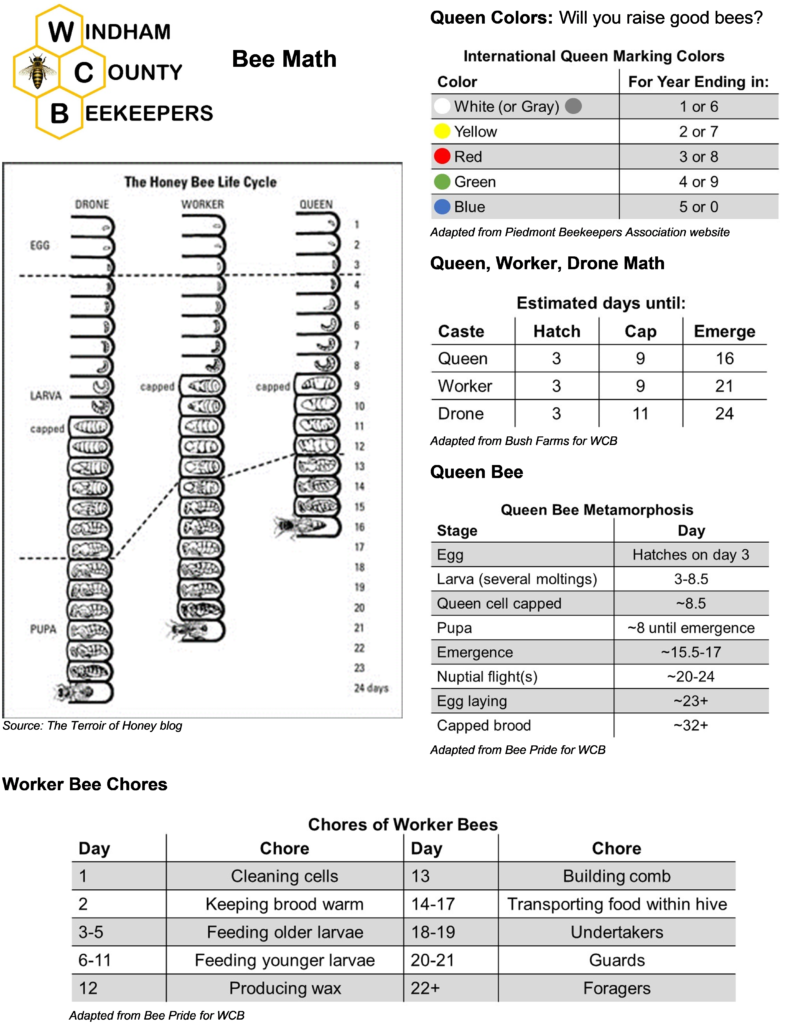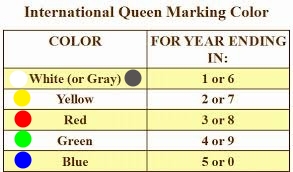A home for educational materials and links related to bees that can help southern VT beekeepers.
Varroa mite cheat sheet
Nice cheat sheet on varroa mite management from the Northeastern IPM Center.


Sustainable Apiary: Mike Palmer Videos
A great synopsis of MIke Palmer’s Sustainable Apiary approach.
Bee Math
This is a collection of bee math that Jeff B put together.

Yearly Management: UMass Amherst
A great source of info – complete with a general calendar for the Northeast:
https://ag.umass.edu/resources/pollinators/honey-bees/information-for-beekeepers/yearly-management
Bee Forensics: Dewey M. Caron
Dewey M. Caron has a nice (short) paper on deadout forensics.
Spring Checklist for Honey Bee Colony Loss
The Ontario Beekeepers’ Association has a nice checklist to help determine reasons for losses.
Diagnosis Key
Here’s a great guide on diagnosing deadout colonies from NY Bee Wellness. This group also offers deadout clinics and presentations and beekeeper workshops.
Deadout Chart
Here’s a link to the hive autopsy (necropsy) chart the Maine State Beekeepers Association uses.
Honey Bee Health Coalition General Guide
HBHC has published a general guide on best management practices for hive health. It’s a nice overview, though not all of the practices listed are good for the northeast. Check out the PDF.
Candy Board Recipe
Here’s Jeff B’s no-cook candy board recipe and instructions:
8F: 8 lbs sugar, 8 oz. water (mix in supplements like ProHealth if you want)
10F: 10 lbs sugar, 10 oz. water (mix in supplements like ProHealth if you want)
- Prep 1/2″ screened shim boards
- Put 4″ 2×4 block where inner cover would be
- Add water to sugar in a bucket
- Put your rubber gloves on and dive in to mix well
- Dump sugar mixture on board and press in firmly
- Put the board near heat until the mixture is dry (a few days)
Inspection Notes
Everybody has their own way of taking notes on their inspections. The format below is what Jeff B currently uses.
Bee Math
Adapted from Bush Bees and Girl Next Door Honey.

Queen Colors
There are five queen bee marking colors that follow a internationally recognized color sequence depending on the last number of the year that the queen was born. Since queens do not live more than 5 years, the color code starts over in the sixth year.
A common mnemonic used by beekeepers to remember the colors is, “Will you raise good bees?”
Here’s a handy color chart from the Piedmont Beekeepers Association:

Breaking the Brood Cycle
One method of varroa mite management: breaking the brood cycle. Figure courtesy of Bee Pride in Lebanon, Maine and the Mid Atlantic Apiculture & Extension Consortium.

Sugar Syrup
Sugar syrup is a good means of supplementing the bees’ nectar flow. Use granulated cane sugar (table sugar). Check with your local bee club or mentor about when you should feed.
In the spring, the syrup should imitate the consistency of nectar. It should be a ratio of 1:1 (1 part sugar, 1 part water).
In the fall, the syrup needs to be mixed in a more concentrated manner because the bees don’t have time to fully process it into honey. It should be a ratio of 2:1 (2 parts sugar, 1 part water).
Mike Palmer Videos
Mike Palmer’s great lecture on the sustainable apiary is available on YouTube. Check out some of his other YouTube videos.
Mike’s apiary is in St. Albans, VT. You can check out his website.
A Worker Bee’s Life

Canada Agriculture and Food Museum
Honey Bee Life Cycle

Source: The Terroir of Honey blog
Beekeeping Calendar for the Northeast
Check out this handy beekeeping calendar from the VBA (originally from the Cornell University Master Beekeeper Program). These are general guidelines and suggestions only.

Adapted from the Cornell University Master Beekeeper Program
